
- Home
- Free Samples
- Premium Essays
- Editing Services
- Extra Tools
- Essay Writing Help
- About Us
- Studentshare
- Subjects
- Miscellaneous
- Hiroshima
Hiroshima - Essay Example

- Subject: Miscellaneous
- Type: Essay
- Level: Undergraduate
- Pages: 4 (1000 words)
- Downloads: 0
- Author: lawson26
Extract of sample "Hiroshima"
Decision to make Hiroshima as the first target of the blast was made after much discussion by a Target committee. It was required to choose a city that was untouched by USAAF strategic air offensives in order to assess the damage caused, and to astonish the Japanese government with the extent of destruction it was supposed to cause. Enemies of Japan very well knew that bombing at Hiroshima will bring the maximum destruction to the city. The bomb was launched by Enola Gay (nick name), a US B29 bomber Tinian (the Pacific island).
The bomb exploded almost 580 m. above the ground, and during the power release, the temperature reached several million degrees centigrade. The sky exploded into flames and the land turned into a living hell. Powerful radiation, heat rays, and severe shock waves were generated out of the huge fire ball created out of the blast. The area was flat and congested with many commercial and administrative buildings. An area of 13 sq. km. (5 sq. mi.) was burned to ashes. Out of the 76,000 buildings in the area, almost 63% were destroyed and just 8% of the buildings escaped from the damages.
The entire issue of The New Yorker August 31 is covered by John Herseys (Pulitzer Prize winner) report on the effects of the atomic bombing on six people. The article was published on the magazine on the first anniversary of Hiroshima bombing incident. The work reflected the author’s experiences in World War II as a war correspondent. His works reflected various problems and grievances related to intolerance and inhumanity. The article was very much popular and appreciated and became a book soon.
The author’s account about the terrific consequences of the bombing was recognized as one of the best and influencing classics of the war. The article was completely based on those six individuals who were highly affected because of the bombing. The author
...Download file to see next pages Read MoreCHECK THESE SAMPLES OF Hiroshima
Hiroshima Bombings Issues
Hiroshima and nagasaki bomb
Impact of Radiation after Hiroshima
Bombing Hiroshima and Nagasaki
A Cartoon Story of Hiroshima
HIroshima Discussion
Hiroshima bombings
The Radiation Exposure in Hiroshima

- TERMS & CONDITIONS
- PRIVACY POLICY
- COOKIES POLICY